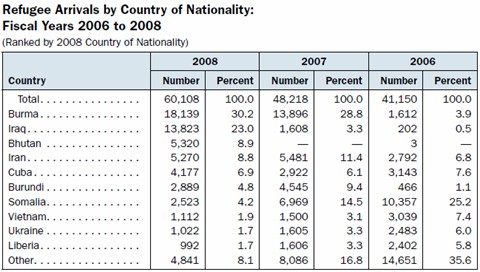
So many statistical goodies to sift through in the latest report on American asylum cases (PDF). But by far our favorite oddity can be glimpsed in the chart above. What’s going on with the Bhutanese? Only three citizens of the isolated kingdom claimed asylum in the U.S. three years ago, and then none in 2007. But then the hordes came last year. What gives? Are the Bhutanese masses far less happy than their monarchical government so famously claims?
In searching for the answer, we noted this cryptic paragraph in the report:
In 2008, the leading countries of nationality for refugee admissions were Burma (30 percent), Iraq (23 percent), and Bhutan (8.9 per cent) (see Table 3). Sixty-two percent of refugees were from these three countries. Iraqi refugee admissions increased over eight-fold from 1,608 in 2007 to 13,823 in 2008. The number of refugees from Bhutan increased from 0 in 2007 to 5,320 in 2008. As part of a 2008 multilateral agreement with six other nations, the United States agreed to resettle up to 60,000 Bhutanese refugees.
It turns out those refugees are part of a persecuted ethnic minority, the Lhotshampas, who’ve spent years living in refugee camps.
Getting those Lhotshampas out of immigration purgatory is an obvious good. But we’re curious regarding the politics of the agreement; the U.S. has recently been relatively hostile to asylum seekers from several other nations with more transparent relevance to our national interests, so why did the Lhotshampas receive such positive treatment? We didn’t realize that our government had such a keen interest in quelling Nepalese-Bhutanese tensions.
Read more about the Lhotshampas resettlement in the U.S. here; many of them are ending up as farm laborers in Vermont.
Update Down in comments, a wise counselor points out that some of the Bhutanese refugees are alighting across the Harlem River from Microkhan HQs.


Brian Moore // Sep 24, 2009 at 4:17 pm
I note with favor the large increase in Iraqi immigrants as well. I think wider immigration (especially from nations that it is pretty terrible to live in, like many on this list) is one of the best, easiest ways that we can improve the general welfare of the world on average.
It is certainly vastly more efficient to transport 1 Somali here than it is to transport the amount of aid to Somalia that are required to bring his or her wellbeing up to an equivalent level, if that were even feasible.
Ben Kallman // Sep 24, 2009 at 4:45 pm
More on Bhutanese refugees from the NY Times: http://www.nytimes.com/2009/09/25/nyregion/25bhutan.html?hp
Brendan I. Koerner // Sep 24, 2009 at 8:14 pm
@Brian Moore: Interesting point. And I’m a big believer in the idea that such immigration is good for the economy, too. Reading The Snakehead just recently gave me a whole new perspective on the issue.
@Ben Kallman: Wow, coincidence. Honestly, hadn’t seen the NYT piece before I posted this. Just added it as an update link. Thx.
Brian Moore // Sep 25, 2009 at 12:43 pm
Oh, you’re definitely right. While the benefit to the immigrant is obvious, I think it helps the destination country as well — which is why I support it so wholeheartedly. You don’t get many win-win solutions when it comes to combating suffering around the world, but this qualifies.
In my opinion, it’s also a win for the departure country. While they are denied the benefit of that citizen, in the long term they will have to craft policies that try to encourage people to stay. Or, they can be horribly repressive and seal their borders, but I’m trying to be optimistic here.
Brendan I. Koerner // Sep 25, 2009 at 3:05 pm
@Brian Moore: Couldn’t agree with you more. I’m a big fan of the whole “vote with your feet” concept.
Also, if a country needs to physically restrain its citizens from leaving (e.g. East Germany, North Korea), all is pretty much lost.
Renewal to the North // Oct 6, 2009 at 9:24 am
[…] of our fascination with the current wave of Bhutanese refugees alighting in the U.S., our favorite correspondent from the Nushagak Bay area alerted us to this great A/V feature from […]